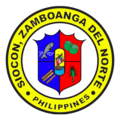Siocon | |
|---|---|
| Municipality of Siocon | |
 Map of Zamboanga del Norte with Siocon highlighted | |
Location within the Philippines | |
| Coordinates: 7°42′24″N122°08′10″E / 7.7067°N 122.1361°E | |
| Country | Philippines |
| Region | Zamboanga Peninsula |
| Province | Zamboanga del Norte |
| District | 3rd district |
| Founded | December 23, 1936 |
| Barangays | 26 (see Barangays) |
| Government | |
| • Type | Sangguniang Bayan |
| • Mayor | Ceasar C. Soriano (PFP) |
| • Vice Mayor | Marlyn M. Duhaylungsod (Lakas) |
| • Representative | Adrian Michael A. Amatong (Liberal) |
| • Municipal Council | Members |
| • Electorate | 30,503 voters (2025) |
| Area | |
• Total | 503.20 km2 (194.29 sq mi) |
| Elevation | 41 m (135 ft) |
| Population (2024 census) [3] | |
• Total | 51,239 |
| • Density | 100/km2 (260/sq mi) |
| • Households | 11,885 |
| Economy | |
| • Income class | 1st municipal income class |
| • Poverty incidence | 47.26 |
| • Revenue | ₱ 341.9 million (2022) |
| • Assets | ₱ 766.6 million (2022) |
| • Expenditure | ₱ 297.9 million (2022) |
| • Liabilities | ₱ 171 million (2022) |
| Service provider | |
| • Electricity | Zamboanga del Sur 2 Electric Cooperative (ZAMSURECO 2) |
| • Water | Siocon Water District |
| • Telecommunications | Globe Telecom |
| Time zone | UTC+8 (PST) |
| ZIP code | 7120 |
| PSGC | |
| IDD : area code | +63 (0)65 |
| Native languages | Subanon Chavacano Tagalog |
| Catholic diocese | Diocese of Dipolog |
| Patron saint | Saint Vincent Ferrer |
| Website | siocon |
Siocon, officially the Municipality of Siocon (Cebuano : Lungsod sa Siocan; Subanen: Benwa Siocan; Chavacano: Municipalidad de Siocan; Tagalog : Bayan ng Siocan), is a municipality in the province of Zamboanga del Norte, Philippines. According to the 2020 census, it has a population of 48,524 people. [5]
Contents
- History
- Geography
- Barangays
- Climate
- Demographics
- Economy
- Education
- Elementary
- Secondary
- Tertiary
- Notable personalities
- References
- External links
Visitors describe Siocon as a "hidden paradise".[ citation needed ]
Local industry includes the Canatuan mine.



